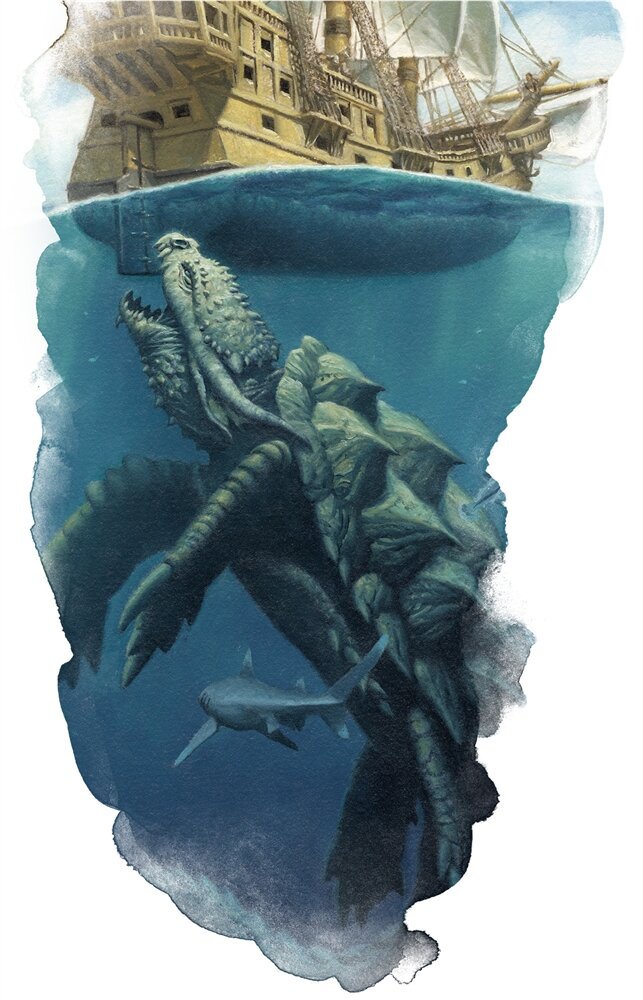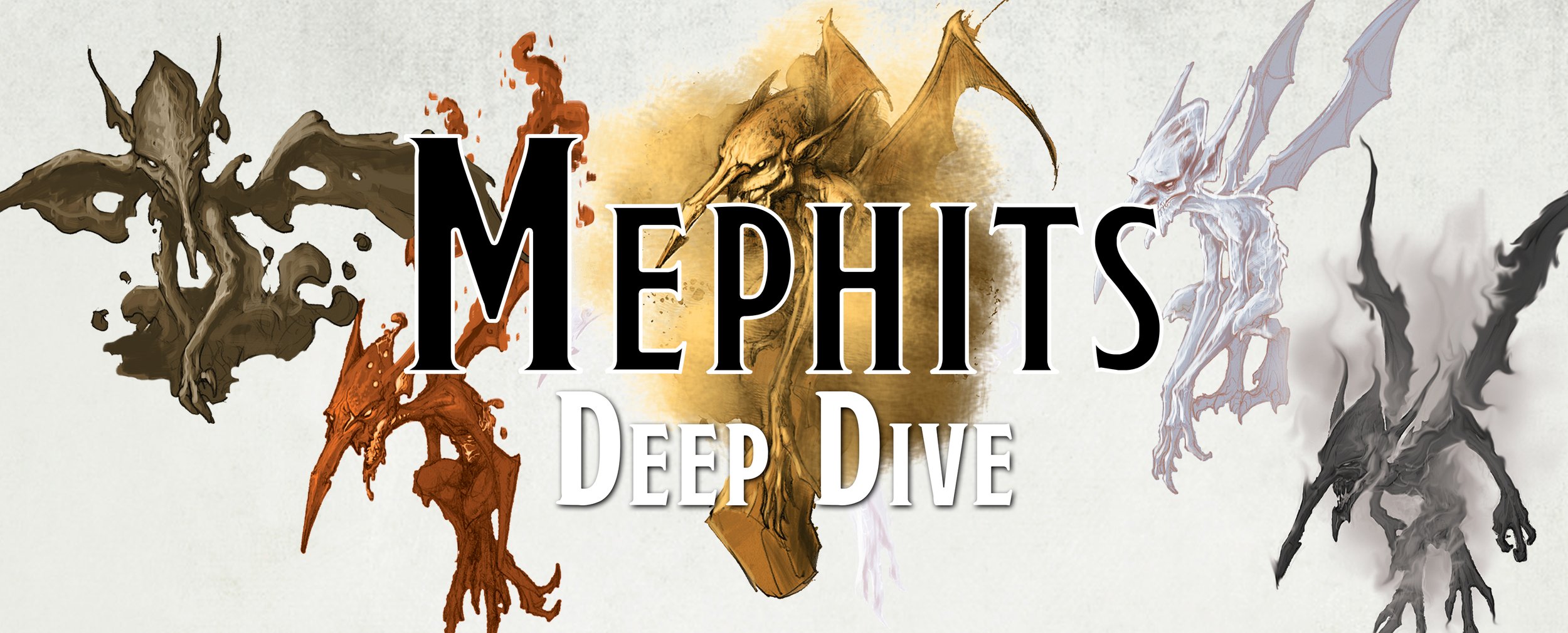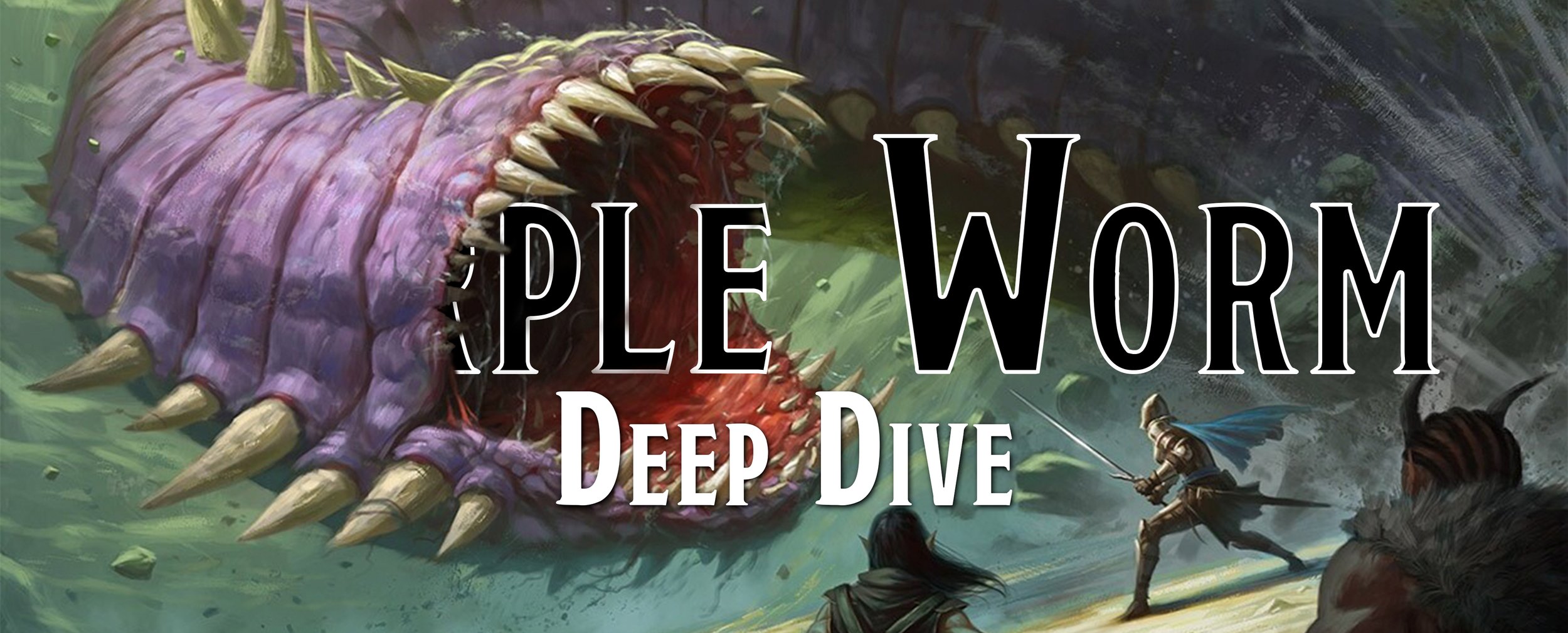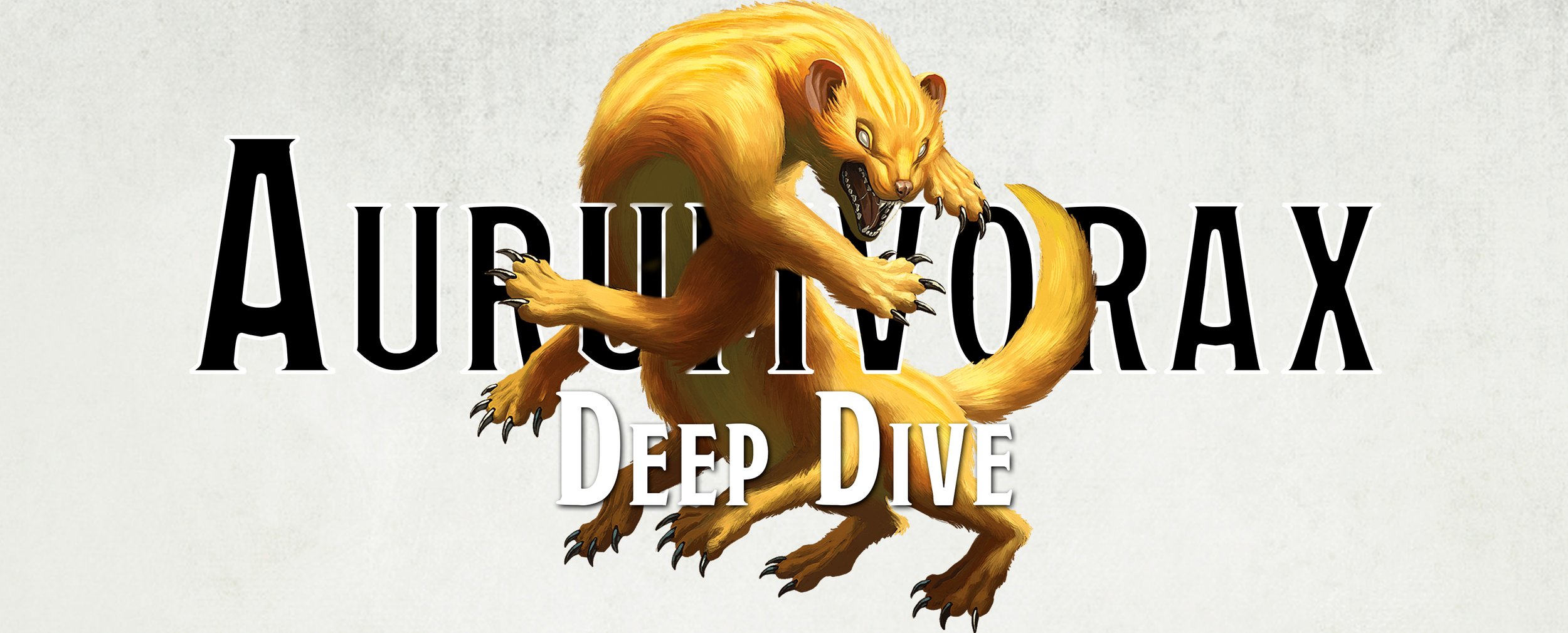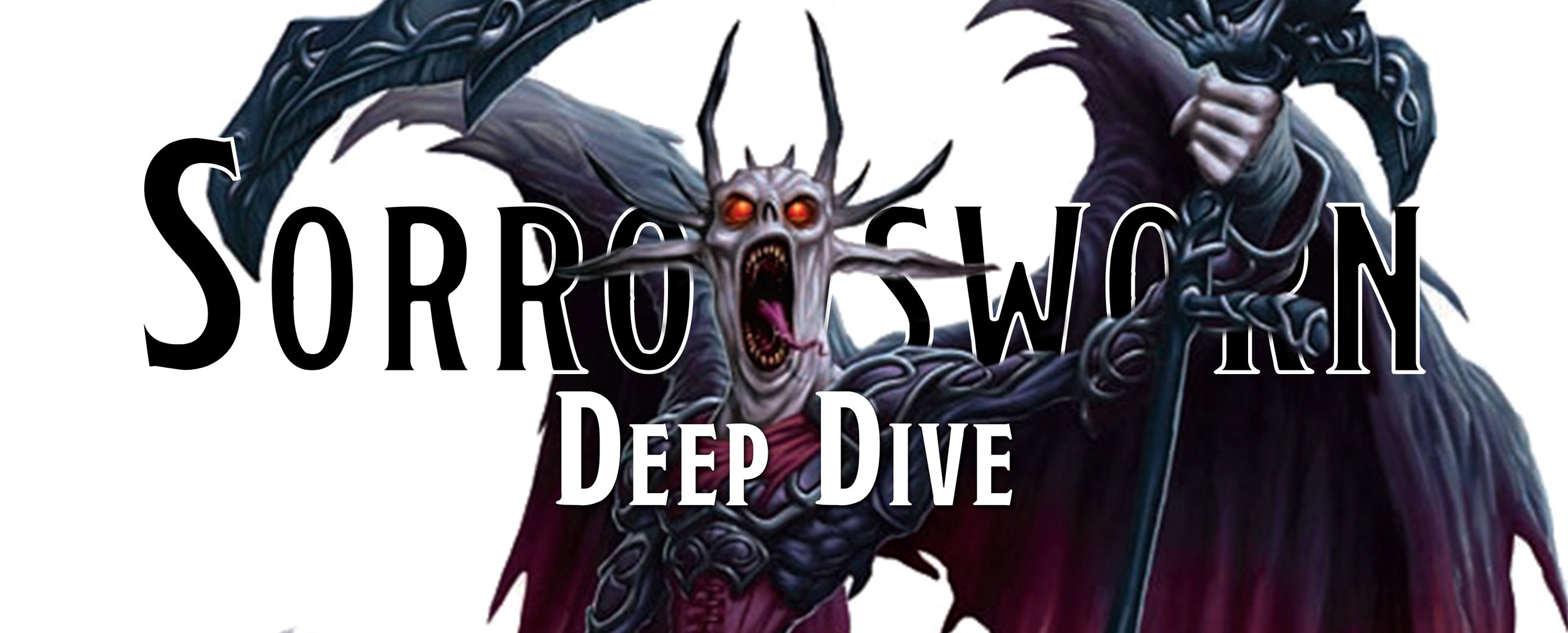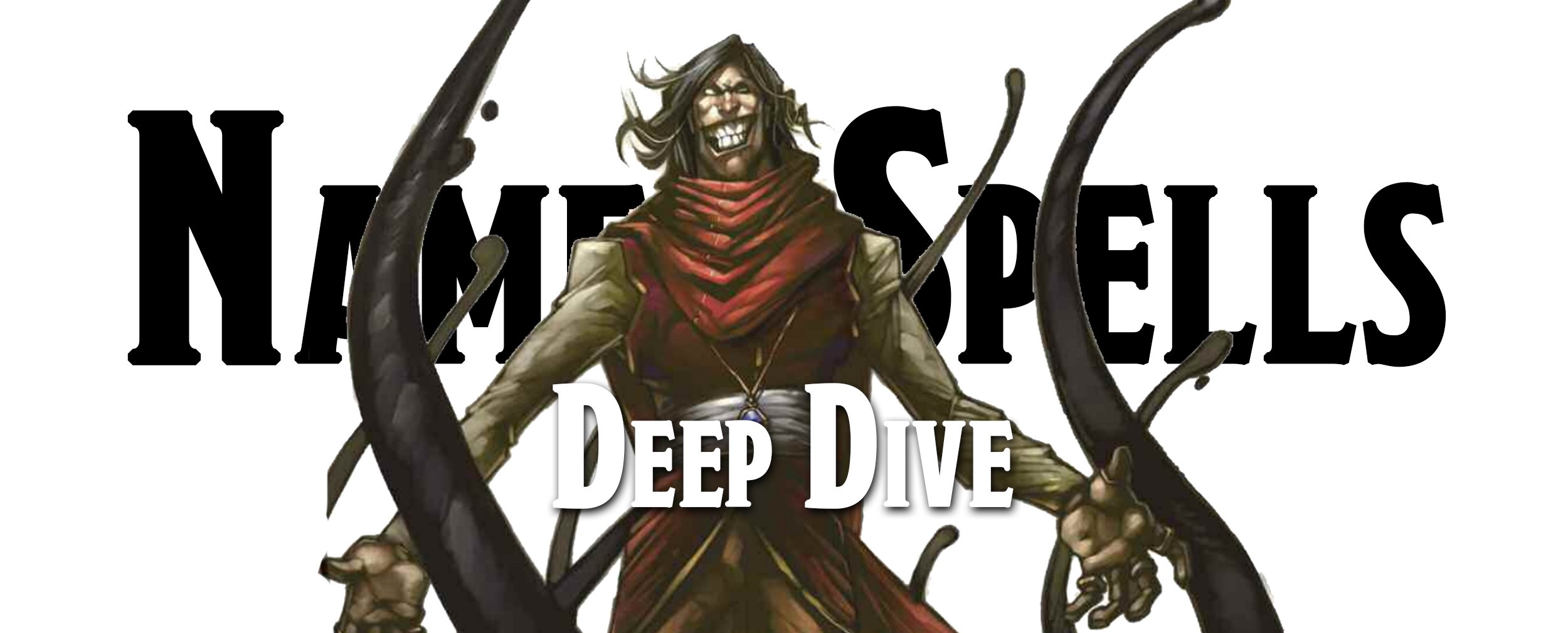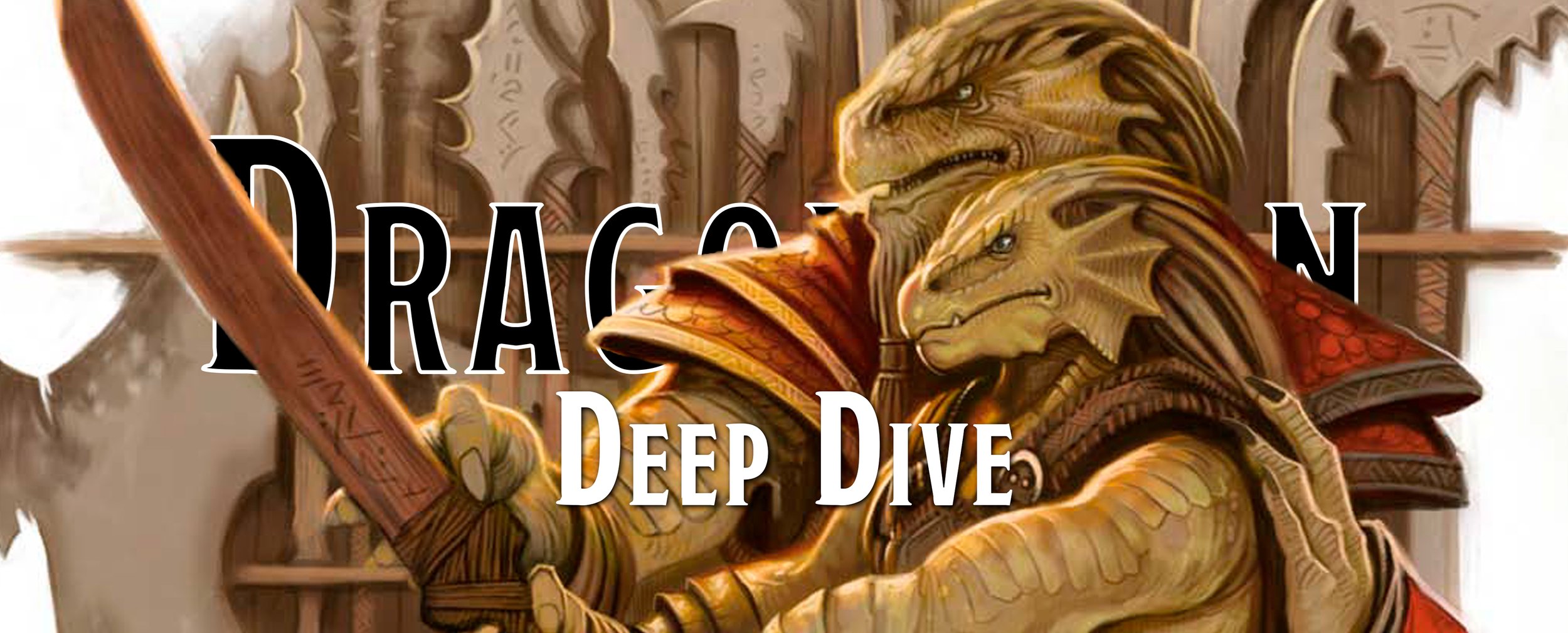Deep Dive - The Dragon Turtle
The Dragon Turtle is a legendary creature from Chinese mythology. It has the body of a turtle and the head of a dragon, which are two of the four celestial creatures found in Chinese mythology. The Dragon Turtle is thought to symbolize courage, determination, fertility, longevity, power, success, and support and, if you practice Feng Shui, you may have a small statue or ornament of a Dragon Turtle in your house facing a window. It is here that the Dragon Turtle will bring you good luck and positive energy.
But the Dragon Turtle pops up in more places than just Chinese mythology. Everyone knows that Mario's arch-nemesis is Bowser. He's one badass Dragon Turtle with a strange habit of kidnapping princesses, a killer ultimate - the Giga Bowser Punch, and never getting to win the final boss battle in any of the Mario games. In Pokemon, Turtonator is a fire/dragon pokemon, also known as a blast turtle, and has a shell that explodes when struck.
And, as you might suspect, the Dragon Turtle even shows up in Dungeons & Dragons. The Dragon Turtle was once the biggest, baddest creature in the sea until he was knocked off his rocky outcropping by the kraken. It’s a shame too because the Dragon Turtle was pretty amazing and a true horror to encounter.
OD&D - Dragon Turtle
No. Appearing: 1-4
Armor Class: 2
Move: 3”/9” (swimming)
Hit Dice: 11-13
% in Lair: 60%
No. of Attacks: Breath Weapon
Damage/Attack: Equal to Dragon Turtle Hit Points
Treasure: Type H
We get our first look at the Dragon Turtle in White Box: Book III: The Underworld and Wilderness Adventures (1974). They are called the most fearsome creatures in the ocean, which is saying a lot since there are sahaugin, killer manta rays, and even giant freaking otters. It makes some sense though seeing as how they were basically dragons, hence their name, and had all the abilities of a dragon except they couldn’t fly and had a slower land speed.
Because they are considered dragons, that meant they get a breath weapon! If you had to guess, what do you think a sea dragon would breathe? If you guessed boiling hot steam, you’d get a cookie. Dragon Turtles breathe a large cone of super-heated steam that is so hot that it deals fire damage equal to its hit points… three times a day. While the three-times-a-day part is a bit sad for it, the fact it deals between 11d6 and 15d6 damage is extremely rough. This is especially rough when you remember that every character only gets a d6 for their hit die in this edition, so you are basically wiping out the entire party in a single breathe.
Beyond the eye-melting steam, Dragon Turtles are given a bit more information though not as much as the rest of the dragons who get 3 pages devoted to how they attack, how you can attack them, how you could subdue them, or how much you can sell your newly subdued dragon for. These massive turtles can live in both fresh- and saltwater, and if you think being on a ship makes you safe well… Dragon Turtles are incredibly strong and if it comes up under a ship, it just lifts it out of the water on to their back. If you find yourself in this situation, well, you’re kinda stuck until it decides to go back underwater. At least you can tell all your friends you once sailed upon a Dragon Turtle!
Basic D&D - Dragon Turtle
Armor Class: -2
Hit Dice: 30
Move: 30’ (10’) / Swimming 90’ (30’)
Attacks: 2 claws/1 bite
Damage: 1-8 claw/10-60 bite
No. Appearing: 0 (1)
Save As: Fighter 15
Morale: 10
Treasure Type: H
Alignment: Chaotic
BECMI Companion Box Set, 1983 TSR Inc.
We first encounter the Dragon Turtle in the Moldvay/Cook Expert Set (1981) and the stat block is later reprinted in the BECMI Companion Box Set (1983), and boy do they make a splash. The Dragon Turtle is so incredibly powerful that there is a special note at the bottom of the description that lets the DM know that they are mighty creatures and not to use them unless the PC's are of exceptionally high level. It’s pretty easy to tell from their stat block that they’ll mess up anything that gets too close to them.
Part dragon, part massive turtle, these creatures live in the deep waters of the ocean, quite content to stay down there for a majority of their lives. It is something that we should all be thankful for, especially if you have any close relatives that make their living on the sea. In the unexplored regions of the bottom of the sea, the Dragon Turtle builds its lair in massive caverns. What do they do with their liars? Why Dragon Turtles, like the dragons they are, like to hoard treasure, magic items, and more that they scavenge from sunken ships. Of course, how those ships came to be sunk is another question.
Alright, we’ll spill the beans. Dragon Turtles will rise up under a ship, flip it over, and then eat everyone. That’s how those ships sank, by a freak force of nature in the form of a dragon and a turtle. If you find it hard to imagine such a massive behemoth the text explains that some have been said to have grown so large that they are mistaken for small islands, and sailors have put down anchor on them before realizing their horrifying mistake. We feel bad for any sailors sailing through an archipelago and playing roulette but with Dragon Turtles and islands.
Dragon Turtles are a combination of the best of being a dragon and a massive turtle. It has the head, limbs, and tail of a typical dragon, but its body is encased in the protective shell of a turtle. If it doesn’t feel like breathing hot steam everywhere, it can instead get up close and personal with three attacks. The first two are with its claws for a rather measly bit of damage that a fighter can laugh off, that is until it bites. It’s bite deals 10 to 60 points of damage, which compared to the 1d8 of its claws is pretty powerful. We suppose there is a reason why the DM is warned by the book that a Dragon Turtle is incredibly dangerous… going back to the breath weapon for just a moment, it still does the same amount of damage as its current hit points, which means it can do up to 30d6 in a 90-foot cone that is 30 feet wide. Better make sure you start hitting it before it breathes on you.
You might be wondering, how dangerous is this monster when compared to others. To put some more perspective on it, a gold dragon only has 11 hit dice and has the same basic attacks as the Dragon Turtle but its bite is only 3 to 36 points (3d12) points of damage.
Though, if you can survive fighting a Dragon Turtle, and somehow swim down to the deepest parts of the ocean, without your lungs collapsing in on themselves, and find its lair... Well, you are about to make it big. The turtle of death is the proud owner of Treasure Type H, which means you could find up to 24,000 copper, 100,000 silver, 60,000 gold, 20,000 platinum, 100 pieces of jewelry, 40 gems, one potion, one scroll, and four magic items of any type or strength. Sure those are maximums, but even one-quarter of that treasure is enough to hang up your sword, buy a tavern, amaze the young adventurers with your war stories, and never, ever, set foot on a ship again.
AD&D - Dragon Turtle
Frequency: Very Rare
No. Appearing: 1
Armor Class: 0
Move: 3”//9”
Hit Dice: 12-14
% in Lair: 5%
Treasure Type: B, R, S, T, V
No. of Attacks: 3
Damage/Attack: 2-12/2-12/4-32
Special Attacks: See below
Special Defenses: Nil
Magic Resistance: Standard
Intelligence: Very
Alignment: Neutral
Size: L (up to 30’ dia.)
Psionic Ability: Nil
Monster Manual, 1977 TSR Inc.
The first line in the Monster Manual (1977) description of the Dragon Turtle tells us that it is probably the most feared creature in the water. That's saying something, considering the Kraken can be found in the Monster Manual II (1983) and the debuff the poor turtle monster gets compared to the previous editions. Hit dice drastically reduced, bite attack cut in half, the size of its breath weapon is shrunk, all we can say is that it’s claw attacks got slightly stronger. But before we get too saddened by this sudden betrayal against the Dragon Turtle, let’s go over how you make one and reveal… it’s not really nerfed.
Not all Dragon Turtles are created equal. Like dragons, you never know if you're going to run into a young or ancient turtle of dragons. In fact, in this version, the DM will roll on the same chart they would for a dragon to determine the age of the Dragon Turtle, which also determines how screwed you are. They roll a d8, the higher the number the older the creature and the more hit points it has per hit die. If the DM rolls a 1, it’s a tiny baby Dragon Turtle with 1 hit point per hit die, so between 12 and 14 hit points. Quite pathetic. Then again, they might roll an 8 and you are looking at an Ancient Dragon Turtle with 96 to 112 hit points and can deal that much damage in its steam breath. The other dragons of this edition all have between 6 to 12 hit die depending on their color, though for some perspective, Tiamat only has 128 hit points. While the numbers look low compared to before, the Dragon Turtle isn’t something to mess with.
Majestic and colorful creatures, they have dark green shells with a lighter green body with streaks of silver highlights. Its shell, not surprisingly, is incredibly hard and nearly impossible to break, which is also its biggest weakness. The turtle lives in saltwater and freshwater, which means if you can just make it to land, you can outpace it. If you stay in the ocean, it’s going to capsize your ship, and then eat you. Jump overboard, make it to land, and you are safe… until you stumble upon the tarasque.
The Dragon Turtle also gets a few brief mentions throughout a few other books, and we will quickly go over those. Appearing in Oriental Adventures (1985), it isn’t given a description but does appear in so far as it’s scales are a spell component for the 9th-level spell, tsunami. Of course, how you are supposed to get those scales is probably an entire quest in and of itself. After that, it shows up in the 1986 module, The Mines of Bloodstone, and is listed as the Lake Midai Monster who attacks boats on the surface of the lake. It gets two sentences devoted to it and one of those sentences is for the DM to reference the Monster Manual for treasure.
It can also be found in the Mad Monkey vs. the Dragon Claw (1988) module about a group of adventurers fighting against a cult in the name of the Mad Monkey. During their adventure, the party has the chance to land on an island that is a massive Dragon Turtle, but will not attack no matter what, but peacefully swim away regardless of the situation. In another book, Kara-Tur: The Eastern Realms (1988), the people of Obakuto in the Forgotten Realms worship a dragon turtle spirit deity. Being the good followers they are, they provide an annual sacrifice to a Dragon Turtle that lives off the coast of the city. Unfortunately for the region’s Dragon Turtles, the barbarians that live in the area hunt them. Another sourcebook, Dreams of the Red Wizards (1988), gives some information for the nation of Thay and reveals that they are lucky enough to be blessed with the presence of Dragon Turtles. Lake Thaylambar, located in central Thay, was said to contain Dragon Turtles since many a fishing boat left port never to return. Or maybe that’s just propaganda, and Thay has a lot of terrible sailors.
It’s hard being a Dragon Turtle, everyone just assumes all you do is capsize ships and eat people… Like our last example in 1988 with the Mists of Krynn mini-adventure series where an 11th-level party is expected to kill a Dragon Turtle. The Dragon Turtle is going on raids across the countryside, and conveniently carries all of its treasure inside of its shell. If the party can destroy the beast, the gnomes are ecstatic and give the party a bunch of strange inventions they’ve been working on. This kind of makes it clear that even on land, you are never safe from a Dragon Turtle, it'll simply walk across the hillsides and destroy everything it can.
Garden of Zinn, 1983 D&D Entertainment
Before we go on to the next edition, we are going to do something we’ve never done before. We are jumping out of the books and into an old animated TV series of Dungeons & Dragons. In the 10th episode of the 1st season, The Garden of Zinn (1983) features a Dragon Turtle. Now, it looks a bit weird but the episode claims its a Dragon Turtle that can… poison you… with its bite. Huh. Well, we’ll be honest, this show is a bit strange and the Dungeon Master is pretty bad. He has the party fight against Tiamat in the first episode, and then comes up with some weird McGuffins to help them defeat her since he wrote himself into a corner.
2e - Dragon Turtle
Climate/Terrain: Subtropical and temperate fresh and salt water
Frequency: Very Rare
Organization: Solitary
Activity Cycle: Any
Diet: Carnivore
Intelligence: Very (11-12)
Treasure: B, R, S, T, V
Alignment: Neutral
No. Appearing: 1
Armor Class: 0
Movement: 3, Sw 9
Hit Dice: 12-14
THAC0: 12 Hit Dice: 9; 13-14 Hit Dice: 7
No. of Attacks: 3
Damage/Attack: 2-12/2-12/4-32
Special Attacks: Breath weapon, capsize ships
Special Defenses: Nil
Magic Resistance: Nil
Size: G (30’ diameter shell)
Morale: Fanatic (17)
XP Value: 12 Hit Dice 10,000/13 Hit Dice 12,000/14 Hit Dice 12,000
Monstrous Compendium Volume 1, 1989 TSR Inc.
In the 2nd edition Monstrous Compendium Volume One (1989) and later reprinted in the Monstrous Manual (1993), the Dragon Turtle is given the proper respect that it has been due, being called beautiful, fantastic, and feared all in the first sentence. Additional imagery of their splendor continues as many an adventurer has thought that a Dragon Turtle shell of the surface of the water is the reflection of the moon or sun. The shell still holds a deep green color, with silver highlights that have the sun's reflection dancing across the water. Their arms, tails, and head are a lighter green color, and its neck has spiked webbing that runs down the top of it. Also, it now specifies that the Dragon Turtle is an intelligent creature and they even have their own highly developed languages, which is the only language they speak.
Being significant and deadly makes you the target for a great many people and puts a target on your back, which is no different for the Dragon Turtle. They live solitary lives deep under the ocean and inhabit large sea caves that are hidden from all but the Dragon Turtle itself, as this where its lives and keeps its treasure hoard. When you sink as many ships as an ancient Dragon Turtle has, your cache is going to contain untold riches, so keeping a secret makes total sense. The area around a Dragon Turtle's lair is considered that turtle's territory and everyone should be wise enough to stay far away. Of course, not everyone gets the memo and the Dragon Turtle is more than happy to destroy your ship, eat you, and then take all your treasure. Though, you can also give great sacrifices of treasure to the Dragon Turtle to simply dissuade it from destroying your ship, think of it as a toll for using its water.
Monstrous Manual, 1993 TSR Inc.
Not everyone is willing to simply give up their hard-earned treasure, and sometimes they want what the Dragon Turtle has. Other sea races, including mermen and sahaugin, find themselves in direct conflict with Dragon Turtle on occasion. Many times this is over territory or underwater caves, but sometimes it could be over treasure or simply because the sahuagin don’t like anything that isn’t a shark. If you find yourself in the middle of a warring faction between Dragon Turtle and sahuagin, sail away quickly. The ocean is vast and wide, and your treasure won’t do you any good if you’re dead.
Before we move on from the Dragon Turtle killing you, lets first talk about a change for them. No longer are their breath weapons tied to how many current hit points they have, instead it just deals a flat 20d6 points of damage which is… well, that’s a lot of steam as it erupts in a 60-foot long, and 40-foot wide cone that will cover all but the largest ships. If you think a Dragon Turtle is about to spew hot steam all over the ship, we recommend hiding below decks… or just jumping overboard and hope it's distracted with the massive chew toy that is the ship.
Once again, beyond the Monster Manuals, the Dragon Turtle is shown very little love. There was a book released called Draconomicon (1990) and the word ‘dragon’ appears over 1,600 times but no mention of the great and fearsome Dragon Turtle. One of the mentions of the Dragon Turtle can be found in the 1993 Forgotten Realms supplement Jungles of Chult which simply says that there are many Dragon Turtles in the waters around Chult and that outside of the city, Port Nyanzaru, the harbormaster pays a monthly tribute to the Dragon Turtle. They claim it is protection from the other monstrous sea creatures that might destroy the city, but we all know it is protect them from the avarice and wrath of that particular Dragon Turtle.
3e/3.5e - Dragon Turtle
Huge Dragon (Aquatic)
Hit Dice: 12d12+60 (138 hp)
Initiative: +0
Speed: 20 ft., swim 30 ft.
Armor Class: 25 (-2 size, +17 natural), touch 8, flat-footed 25
Base Attack/Grapple +12/+28
Attacks: Bite +18 melee (4d6+8)
Full Attack: Bite +18 melee (4d6+8) and 2 claws +13 melee (2d8+4)
Space/Reach: 15 ft./10 ft.
Special Attacks: Breath weapon, snatch, capsize
Special Qualities: Darkvision 60 ft., immunity to fire, sleep, and paralysis, low-light vision, scent
Saves: Fort +13, Ref +8, Will +9
Abilities: Str 27, Dex 10, Con 21, Int 12,Wis 13, Cha 12
Skills: Diplomacy +3, Hide +7*, Intimidate +16, Listen +16, Search +16, Sense Motive +16, Spot +16, Survival +16 (+18 following tracks), Swim +21
Feats: Blind-Fight, Cleave, Improved Bull Rush, Power Attack, Snatch
Climate/Terrain: Temperate aquatic
Orgnization: Solitary
Challenge Rating: 9
Treasure: Triple standard
Alignment: Usually neutral
Advancement: 13–24 HD (Huge); 25–36 HD (Gargantuan)
Level Adjustment: -
Monster Manual, 2000 WotC
The Dragon Turtle premiered in the 3rd edition Monster Manual (2000) and was later revised in the 3.5 edition's Monster Manual (2003). There are a few changes between the two stat blocks, and they have a significant impact on how much more powerful the Dragon Turtle is in 3.5e. The AC of the Dragon Turtle increases from 20 to 25, which is quite the jump as well as the 3.5e version receiving additional bonuses in Diplomacy, Sense Motive, Survival, and Swim skills - with swim alone being a 21 point addition. While they lose their Alertness feat, they more than make up for it by adding the Improved Bull Rush and Snatch feats. We're sure that trading a higher initiative bonus for being able to grab creatures with your mouth works out in the Dragon Turtle’s favor. Sadly, its steam breath weapon range is nerfed a bit, with the steam cloud now a 50-foot cone that is 25 feet wide, and the damage is knocked down to 12d6. To compensate, the Dragon Turtle can now use the weapon every 1d4 rounds.
Despite the many mechanical changes, there is basically no lore changes between 3e and 3.5e and very few between 2e and 3e. While you might think having a Dragon Turtle as a pet would be a good thing, keep in mind that they can weigh up to 32,000 pounds - which we can only imagine would make it very hard to find a big enough stable for them. They can also grow quite long with the largest getting as long as 40 feet and their shell up to 30 feet in diameter. Now, you might be wondering why we are talking about a Dragon Turtle being a pet, and it’s not to give your players any ideas!
Stormwrack - Mastering the Perils of Wind and Wave, 2005 WotC
No, we bring up the Dragon Turtle being a pet because it can actually make a great companion… for a storm giant. In the setting-neutral and exploration-focused supplement, all about underwater realms and terrains, Stormwrack - Mastering the Perils of Wind and Wave (2005) provides a huge amount of inspiration and descriptions about underwater combats, explorations, and roleplaying moments. One of those comes in the form of a storm giant, Tamoreus, who finds an ancient Turtle Dragon, known as Queen of Mists, kills her (barely), and then takes over her lair. He ends up finding a nest of Dragon Turtle eggs, eats most of them but keeps one alive who he eventually calls Galoril. Together, as companions, they have set up a massive territory beneath the waves and destroy any intruders who enter their realm. Ship captains all avoid their territory, preferring to instead sail for weeks out of the way then face certain death in the mist-laden waves of Tamoreus’ and Galoril’s realm.
And what has become common, we once again must dive a bit deeper than usual to find any references we can get about the Dragon Turtle. In fact, we checked several books all about dragons that had either a single sentence about the Dragon Turtle or didn’t mention it in the least! Books like Draconomicon (2003), Races of the Dragon (2006), Dragon Magic (2001), Dragon Compendium (2005), Dragons of Eberron (2007), and more barely mentioned or didn’t even mention the most important dragon to ever swim through the vast oceans of the world. But even if we had to check every book ever released in 3e, we were going to find something more to talk about.
Luckily for all of you, sort of, we found a few brief mentions of the Dragon Turtle worth sharing. The first example is in the Unapproachable East (2003) which simply restates what we know about that one lake in Thay, which is nice. Glad to hear that that Dragon Turtle is still causing lots and lots of trouble. Up next is Dragons of Faerun (2006) which features a dragon cult that has bribed a Dragon Turtle to protect a lighthouse they are running their operations in. And that’s it.
We’re sure it can’t get worse for the Dragon Turtle and things will turn around in 4e! If there is one great thing about 4e, it always has 3 or 4 different versions of the same monster! It’s going to be turtles all the way down!
4e - Dragon Turtle
Gargantuan dragon, neutral
Armor Class 17
Hit Points 149 (13d12 + 65)
Speed 20 ft., swim 40 ft.
Str 25 (+7) Dex 10 (+0) Con 20 (+5) Int 10 (+0) Wis 12 (+1) Cha 12 (+1)
Saving Throws Dex +4, Con +9, Wis +5
Special Senses darkvision 60 ft.
Immunities doesn’t sleep, can’t be paralyzed
Resistances fire
Languages Draconic, Primordial (Aquan)
Aquatic. The dragon can breathe air and water.
Multiattack. The dragon makes one bite attack and two claw attacks.
Bite—Melee Attack. +7 to hit, reach 10 ft., one creature. Hit: 20 (2d12 + 7) piercing damage.
Claw—Melee Attack. +7 to hit, reach 5 ft., one creature. Hit: 14 (2d6 + 7) slashing damage.
Tail—Melee Attack. +7 to hit, reach 10 ft., one creature. Hit: 21 (3d8 + 8) bludgeoning damage, and the creature must succeed on a DC 19 Strength saving throw or be pushed up to 10 feet away from the dragon and knocked prone.
Steam Breath (Recharge 6). The dragon breathes scalding steam in a 60-foot cone. Each creature in the cone must make a DC 12 Dexterity saving throw, taking 21 (6d6) fire damage on a failed save, or half as much damage on a successful one.
Those of our readers who like to read through the stat blocks might notice something a bit odd about the 4e stat block above us. We’ll explain in just a moment, but first, let’s just say that we vastly overestimated how much 4th edition was going to bring for the Dragon Turtle. Scouring every single book we could find in that edition, we finally located the Dragon Turtle and it’s… well, it's very unfortunate for this poor creature.
In the 2008 Forgotten Realms Campaign Guide and the Forgotten Realms Player’s Guide, we get our first mention of the Dragon Turtle. The Campaign Guide simply says that there is a lake, Lake Thaylambar, has Dragon Turtles and that necromancers have made undead one and they serve in the Thay navy. The Player’s Guide makes one mention of a Dragon Turtle being in the sunken city of Soorenar and that’s it. Well… better than nothing like we originally thought was going to be in this edition.
Except, we aren’t done! The Dragon Turtle makes a sudden appearance in the 11th season of the D&D Encounters program in the adventure War of Everlasting Darkness (2011). In this adventure, a Dragon Turtle acts as an obstacle to adventurers trying to make it over a lake. Someone stole all of the turtle’s eggs and she is now quite angry. She is meant to be a bit of a roadblock and has no real stat block, instead she just absorbs any hit that might be dealt by a character, as they are only low level at this point in the adventure, and then hits them with a steam breath that the adventure kind of shrugs and admits might kill an adventurer but they shouldn’t have angered her. If the adventurers can get past this difficult social encounter, they can pass safely through the lake and find the drow they are hunting afterward, who probably also stole the Dragon Turtle’s eggs!
Now we can talk about the weird stat block for this edition. In 2014, 5th edition was released, but before the official release of 5e, there was also D&D Next which was the prototypes of the 5e rules. In the 18th season of the D&D Encounters program in the adventure Dead in Thay (2014), we are finally given a stat block for a Dragon Turtle! It has nothing to do with 4e mechanics and the poor Dragon Turtles are simply juveniles, but hey, it only took the entire life cycle of 4e before we got a Dragon Turtle, but we got it! The Dragon Turtles in this have been captured from the Lake Thaylambar and wish to be freed, which the players can help with… or just fight them for that sweet XP.
5e - Dragon Turtle
Gargantuan dragon, neutral
Armor Class 20 (natural armor)
Hit Points 341 (22d20 + 110)
Speed 20 ft., swim 40 ft.
Str 25 (+7) | Dex 10 (+1) | Con 20 (+5), | Int 10 (+0) | Wis 12 (+1) | Cha 12 (+1)
Saving Throws Dex +6, Con + 11, Wis +7
Damage Resistances fire
Senses darkvision 120ft., passive Perception 11
Languages Aquan, Draconic
Challenge 17 (18,900 XP)
Amphibious. The dragon turtle can breathe air and water.
Multiattack. The dragon turtle makes three attacks: one with its bite and two with its claws. It can make one tail attack in place of its two claw attacks.
Bite. Melee Weapon Attack: +13 to hit, reach 15 ft., one target. Hit: 26 (3dl2 + 7) piercing damage.
Claw. Melee Weapon Attack: +13 to hit, reach 10 ft., one target. Hit: 16 (2d8 + 7) slashing damage.
Tail. Melee Weapon Attack: +13 to hit, reach 15 ft., one target. Hit: 26 (3dl2 + 7) bludgeoning damage. If the target is a creature, it must succeed on a DC 20 Strength saving throw or be pushed up to 10 feet away from the dragon turtle and knocked prone.
Steam Breath (Recharge 5-6). The dragon turtle exhales scalding steam in a 60-foot cone. Each creature in that area must make a DC 18 Constitution saving throw, taking 52 (15d6) fire damage on a failed save, or half as much damage on a successful one. Being underwater doesn't grant resistance against this damage.
Monster Manual, 2014 WotC
As we arrive in 5th edition and gaze upon the Dragon Turtle in the Monster Manual (2014), we can't help but be a little disappointed. The Dragon Turtle falls in line with most adult dragons, landing somewhere in the middle of the pack, especially when you look at hit points and AC. Where it falls short is in the actions it can do in combat, which on the positive side, it does gain a tail attack that was not present in the older editions. Their breath weapon attack is weaker than other dragons, they lack a Frightful Presence, don’t have Legendary Actions, and are just more limited. In the earliest editions, Dragon Turtles were stronger than even the greatest of dragons and had their abilities, and yet it has now fallen behind.
The Dragon Turtle is still a massive creature with a dark green and silver-streaked shell and still loves treasure. It will sink any ships it comes across, killing everyone and taking any treasure it may find among the wreckage. New fun fact - the Dragon Turtle swallows the treasure it finds so that it can get it back to its lair, which makes sense since there is no mention of them having a bag of holding in their equipment list. Once back at the hideout, they puke up the treasure onto what we can only imagine is an evergrowing hoard. Puking it up may not sound pretty, but it's way better than the other option to pass the treasure from its stomach and luckily, the lair is underwater so any grossness should clean right off!
In addition to behaving like the normal Dragon Turtle, they are also dumbed down just a bit as they are given only average intelligence instead of just slightly above average. They are clever enough to know a good deal when they see it and will work with denizens of the deep if given enough gold and treasure. They have even been spotted on the Elemental Plane of Water as mounts for the marids, though that’s probably not by their choice. It’s a hard fall from being the most feared creature in the sea with even the kraken scared of you.
Forgotten Realms still loves The Dragon Turtle as the make an appearance in the adventure book Tales from the Yawning Portal (2017) which features a reprint of the D&D Next adventure, Dead in Thay (2014). The major difference here is that there is only one Dragon Turtle instead of two and it is a ‘reduced threat’ version, which gives it half its normal hit points and has a -2 penalty to pretty much everything it tries to do. It’s basically a juvenile at that point.
Dragon Turtles make a few more appearances, nothing major, in the books Princes of the Apocalypse (2015), Ghosts of Saltmarsh (2018), and the Explorer’s Guide to Wildemount (2020) which all feature pretty much the same thing. There is a Dragon Turtle, and it is guarding something or wants more treasure. The party then has to talk to the creature and come to an understanding with it, typically by giving it lots and lots of treasure.
Tomb of Annihilation, 2017 WotC
Lastly, we have the adventure Tomb of Annihilation (2017) which brings us back to the Forgotten Realms in the city of Chult. Outside of the main port, Port Nyanzaru, which you might remember we briefly talked about back in 2e, it still has a Dragon Turtle problem and all merchants must offer it tribute to sail the Bay of Chult. Named Aremag, this Dragon Turtle has seen better days as it's blind in one eye and missing part of his shell. Like all Dragon Turtles, he is incredibly greedy and demands a lot of gold to not kill everyone and destroy the ship. So, it’s pretty much like every other adventure that mentions a Dragon Turtle.
Throughout every edition, even 4th, Dragon Turtles have found a few sentences here and there to sneak into. The creature was set up to be this colossal creature who could defeat krakens and be this massive and powerful force of nature to throw against your party when in reality it ended up just being a roadblock or random encounter. The Dragon Turtle is treated more as an afterthought throughout the history of Dungeons & Dragons and barely even shows up in many of them.










